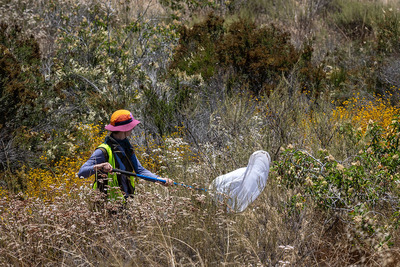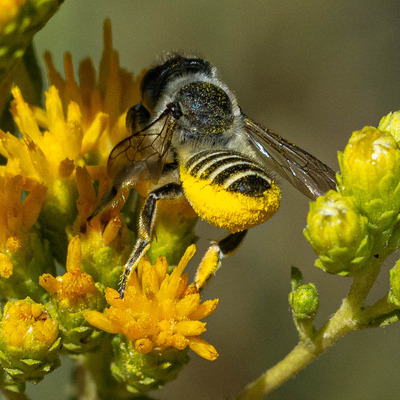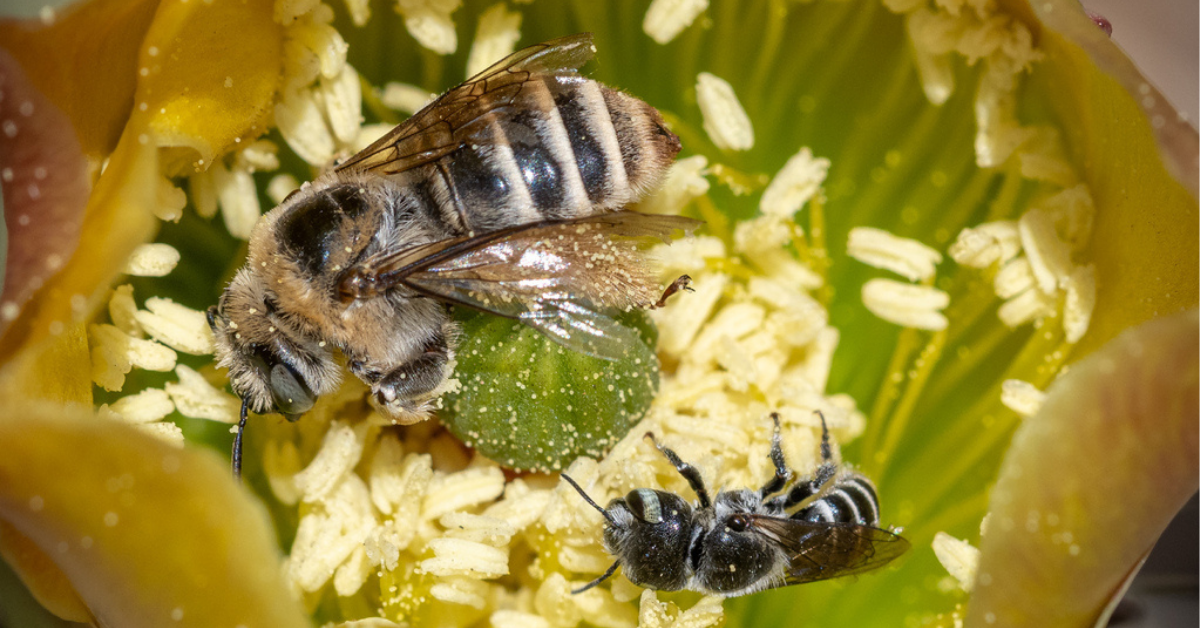Bee-lieve It or Not: 8 Fascinating Bee Facts for World Bee Day
Story by:
Published Date
Article Content
Every May 20, World Bee Day is celebrated worldwide to raise awareness of the importance of bees and pollinators, as well as the threats they face. Designated by the United Nations, this occasion also offers an opportunity to learn more about their vital contributions to the planet and explore ways to protect their future.
UC San Diego Today sat down with Jess Mullins, a Ph.D. student in the Ecology, Behavior, and Evolution Department, to dive deeper into the world of bees and uncover fascinating insights about these pollinators. As a researcher in Professor David Holway's lab, Mullins investigates native bees and how they respond to habitat loss. On May 20, in observance of World Bee Day, she will present a free lecture at noon on native bees at Geisel Library’s Seuss Room.

Ahead of her lecture, Mullins is sharing the "buzz" on bees with these eight facts:
San Diego County is home to over 700 bee species
The local region is a global biodiversity hotspot, boasting over 700 native bee species in San Diego County alone, which is more than 20% of the bee diversity in the United States. Worldwide, there are more than 21,000 bee species.
“Native bee” is a term that helps distinguish local bee species from Western Honey Bees
The term “native bee” distinguishes the local bee species from the Western Honey Bee, which was introduced to North America by early Europeans. Community members who visit UC San Diego can see native bees fly around from plant to plant across campus. Bees also like living in places where there are seasonal synced blooms—for example, California’s flower super blooms are a feast for pollinators!
Honey bees were introduced in the 1600s by early Europeans
Honey bees were first introduced to North America in the 1600s by Europeans who used bees for honey, wax and pollination services. While honey bees are an introduced species in Southern California—meaning not indigenous, or native, to the area—they do well in the region’s natural environment.
Contrary to popular belief, honey bees are not in decline
While much love and attention is directed toward saving the honey bees, they are no longer in decline in commercially managed settings. Honey bees in the United States have reached an all-time high with a 31% increase (over 1 million colonies) since 2007, when concern over the decline in commercially managed bee colonies was first raised.

Only female bees can sting
Only female bees can sting because the mechanism they use to sting is also the one they use to lay eggs. In the case of honey bees, most are also female “workers” who collect pollen and nectar for colony maintenance. Male bees are unable to collect pollen. If you see lots of honey bees entering a cavity in the ground or a tree hollow, steer clear and you are less likely to be stung.
Most bee species are solitary
A common misunderstanding is that bees mostly live together in groups. For instance, when we think of bees, we often imagine a queen surrounded by worker bees collaborating in a beehive. In reality, approximately 70% of the 21,000 bee species worldwide are solitary. This means that a single female bee builds a nest, lays an egg on a pollen ball and seals it off. Solitary bees emerge from their nest the following season and mother bees never interact with their offspring. Most bees also build their nests underground.
Habitat loss and climate change are the biggest threats to biodiversity loss
Habitat loss and climate change pose the two greatest threats to biodiversity, including bees. When events like floods or excessive pesticide use occur in bee habitats, they often abandon the area and do not return.

Their messy eating habits help them effectively pollinate plants
Bees are effective pollinators thanks to their messy eating habits. Pollen and nectar serve as their primary sources of protein and carbohydrates. As bees gather nectar and pollen, they frequently transfer pollen from one flower to another, aiding in plant reproduction. Their bodies also have various adaptations for this task: some have long hairs on their belly, others have hairy legs that look like bell bottom pants, and some even feature tiny baskets on their legs they use to store nectar and pollen.
As a designated Bee Campus, UC San Diego actively promotes pollinator health and conservation through initiatives such as pollinator gardens, educational programs and research. The university became a member of Bee Campus USA under the leadership of Associate Dean of the Division of Biological Sciences Dr. James Nieh, who spearheaded efforts and works with The Pollinator Club to support pollinators and establish pollinator-friendly habitats on campus.
To learn more about the World Bee Day lecture, please visit the event website. More information about UC San Diego’s status as a Bee Campus USA member can be found in this UC San Diego Today story.
Share This:
You May Also Like
Stay in the Know
Keep up with all the latest from UC San Diego. Subscribe to the newsletter today.




